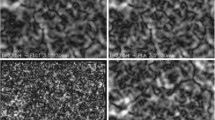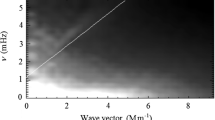Abstract
From time series of high resolution photographs, morphological properties of the photospheric facular granules were derived. The facular granules are cells of the common granular pattern, brighter than the normal granules when seen between cos θ = 0.6 and the limb. Their apparent diameter, which decreases towards the limb, is smaller than that of the normal granules: 0″.65 and 1″.25 respectively at cos θ = 0.55; their lifetime is 25 min but their ‘bright stage’ lifetime is only 15 min; they are visible closer to the limb than the normal granules: 1″.2 compared to 2″–5″; the brightening of the facular granules occurs at a faster rate than their fading. From the great similitude of both morphological properties and temperature models of facular and normal granules, it appears possible that the photospheric facular granules are convective cells modified by the presence of a magnetic field of some hundreds Gauss.
Similar content being viewed by others
References
Bray, R. J. and Loughhead, R. E.: 1961, Australian J. Phys. 14, 14
Bray, R. J. and Loughhead, R. E.: 1967, The Solar Granulation, Chapman and Hall, London.
ten Bruggencate, P.: 1940, Z. Astrophys. 19, 59
Chapman, G. A. and Sheeley, N. R.: 1968, Solar Phys. 5, 442
Edmonds, F.: 1962, Astrophys. J. Suppl. 6, 367
Frazier, E. N.: 1971, Solar Phys. 21, 42
Gingerich, O., Noyes, R. W., Kalkofen, W., and Cuny, Y.: 1971, Solar Phys. 18, 347
Kulsrud, R. M.: 1955, Astrophys. J. 121, 461
Kuperus, M.: 1969, Space Sci. Rev. 9, 713
Livshits, M. A.: 1963, Soviet Astron. 7, 28
Mehltretter, J. P.: 1974, Solar Phys. 38, 43
Muller, R.: 1973, Solar Phys. 29, 55
Muller, R.: 1974, paper presented at the 7th Regional Consultation on Solar Physics, Starý Smokovec, Czechoslovakuia.
Muller, R.: 1975, Solar Phys. 45, 105
Osterbrock, D. E.: 1961, Astrophys. J. 134, 347
Rogerson, J. B.: 1961, Astrophys. J. 134, 331
Schröter, E. H.: 1962, Z. Astrophys. 56, 183
Stein, R. F.: 1968, Astrophys. J. 154, 297
Waldmeier, M.: 1940, Helv. Phys. Act. 13, 13
Wilson, P. R.: 1969, Solar Phys. 6, 364
Author information
Authors and Affiliations
Rights and permissions
About this article
Cite this article
Muller, R. Morphological properties and origin of the photospheric facular granules. Sol Phys 52, 249–262 (1977). https://doi.org/10.1007/BF00149643
Received:
Revised:
Issue Date:
DOI: https://doi.org/10.1007/BF00149643




